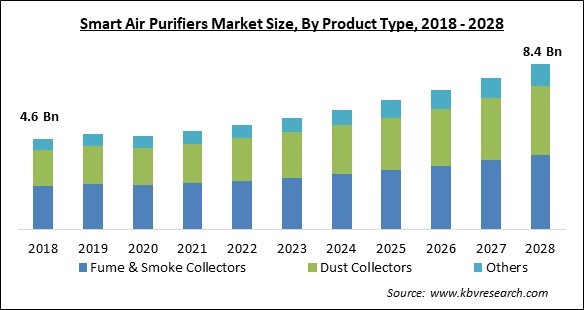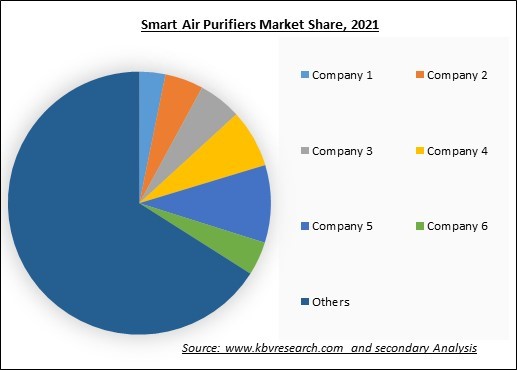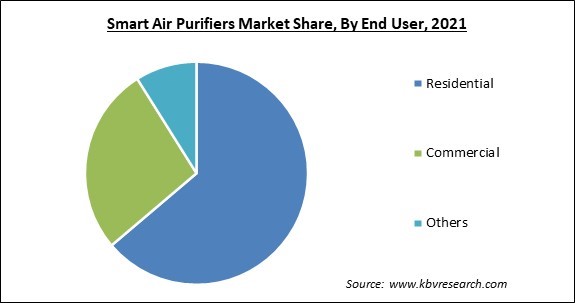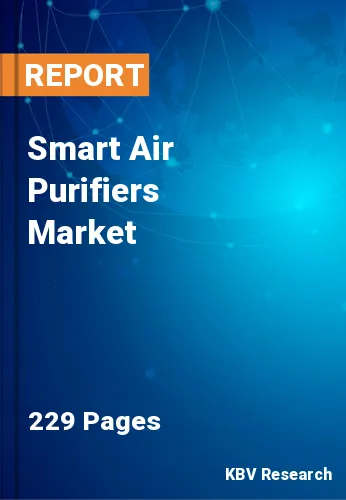The Global Smart Air Purifiers Market size is expected to reach $8.4 billion by 2028, rising at a market growth of 7.9% CAGR during the forecast period.
Air purifier devices have been around for a long time. Certain air purifiers called smart air purifiers now come equipped with Wi-Fi capabilities, due to technological advancements. This means users don't have to manually turn it on and off or check the filters to make sure they're clean; instead, they are able to control and monitor the purifier from their phone.

Dust, dust mites, pet dander, mold, smoke particles, car exhaust, kitchen smoke, and gaseous pollutants are all removed by air purifiers. Smart air purifiers use a smartphone-enabled app to monitor and adjust air quality, as well as to provide real-time readings of quality data. The gadget also allows users to measure indoor air quality over time, allowing them to see when the time of day has the best and worst air quality. The use of smart air filtration and purifier solutions is expected to increase as air quality continues to deteriorate due to high smoking, pollution, and PM2.5 levels.
The World Health Organization (WHO) estimates that 9 out of 10 people breathe contaminated air with high levels of contaminants. According to the report, roughly 7 million people die prematurely each year as a result of outdoor and interior air pollution, with 3.8 million dying as a result of indoor air pollution. Over the projected period, the smart air purifiers market is expected to be driven by deteriorating air quality across regions and increased awareness about the benefits of using air purifiers.
Indoor pollutants and PM2.5 levels above a certain threshold increase the risk of respiratory disorders, heart disease, cancer, dizziness, fatigue, asthma, and eye irritation, among other ailments. To address the increased demand, manufacturers concentrate on product innovation and new product releases.
Due to the COVID-19 pandemic, many companies in the smart air purifiers industry were compelled to temporarily suspend operations in order to comply with new government rules aimed at preventing the disease's spread. This suspension in operations had a direct influence on the air filter market's revenue flow. In addition, due to a scarcity of raw materials and people during the lockdown, the manufacturing of industrial products has come to a halt. Furthermore, enterprises in this industry did not get any fresh consignments. As a result, the suspension of industrial activities and the subsequent lockdown for several months had an impact on the market share of smart air purifiers, and the market is expected to recover slowly during the projection period.
Developing countries such as China and India have very pollution levels and many areas in these countries have extremely high air quality index levels. Thus, residents of these areas are expected to install air purifiers in their homes to at least keep the indoor air clean and fresh. The market is expected to develop due to the rising demand for anti-pollution goods as pollution levels rise. The rising prevalence of airborne infections is expected to accelerate product adoption in the near future in developing countries. Cleaning the air using an air purifier also helps to clean the rest of the house. Pollen, mold spores, dust mites, human skin cells, hair, and insect debris are among the airborne particles that make up dust, and air purifiers with a HEPA filter may trap them.

The leading players in the market are competing with diverse innovative offerings to remain competitive in the market. The below illustration shows the percentage of revenue shared by some of the leading companies in the market. The leading players of the market are adopting various strategies in order to cater demand coming from the different industries. The key developmental strategies in the market are Product Launches.
Mold, pet dander, pollen, and germs are all airborne particles that can cause allergies and asthma episodes. Indoor air quality can be up to five times worse than outside air quality, according to the US Environmental Protection Agency. As a result, having a top-quality True HEPA filter in the house can help regulate allergies and asthma by reducing the number of allergens and asthma-inducing particles in the air one breathes. This benefit has led to an increase in the demand for smart purifiers. Many common household products can potentially release dangerous pollutants into the air for up to two years. Building supplies, adhesives, wall paint, furniture, and cleaners are all examples.
Air purifiers create some noise, even if it is not excessive, and one should assess how much noise one can endure. Especially if one wants to use it for anything like working from their home office. The sound level of a quiet air purifier is usually between 30 and 40 dB. To mild rainfall, this is roughly as loud as a whisper. Some air purifiers, on the other hand, can produce up to 70 decibels, which is comparable to traffic noise and will undoubtedly be an annoyance. An air purifier's noise and light might be distracting, especially late at night when someone is attempting to sleep. Some air purifiers are rather large, and they can be a nuisance.
Based on Technique, the market is segmented into High-efficiency Particulate Air (HEPA), Activated Carbon Filtration, Thermodynamic Sterilization System (TSS), Ultraviolet Germicidal Irradiation, Ionizer Purifiers, and Others. The high-efficiency particulate air (HEPA) segment acquired the largest revenue share in the smart air purifiers market in 2021. This is because this solution can remove 99.97 percent of pollutant particles. HEPA is a sort of mechanical filter that traps hazardous particles such as pollen, dust mites, tobacco smoke, and other contaminants by pulling air through a small mesh.

Based on Product Type, the market is segmented into Fume & Smoke Collectors, Dust Collectors, and Others. The dust collectors market procured a significant revenue share in the smart air purifiers market in 2021. Many air purifiers on the market are made to filter out big dust particles. Mechanical filtration, which is a method of capturing contaminants on filters, is used in many of them. The particles are either supposed to cling to the filter or get caught in the filter fibers.
Based on End User, the market is segmented into Residential, Commercial, and Others. The residential segment acquired the largest revenue share in the smart air purifiers market in 2021. Owing to its ease of use and great efficacy in cleaning viruses, germs, pollen, pet dander, and smoke during cooking, smart air purifiers have seen an increase in demand in the home market in recent years. Furthermore, due to rising pollution levels in cities such as India and China, the adoption of smart air purifiers in the residential sector is likely to rise in the future.
| Report Attribute | Details |
|---|---|
| Market size value in 2021 | USD 5 Billion |
| Market size forecast in 2028 | USD 8.4 Billion |
| Base Year | 2021 |
| Historical Period | 2018 to 2020 |
| Forecast Period | 2022 to 2028 |
| Revenue Growth Rate | CAGR of 7.9% from 2022 to 2028 |
| Number of Pages | 236 |
| Number of Tables | 379 |
| Report coverage | Market Trends, Revenue Estimation and Forecast, Segmentation Analysis, Regional and Country Breakdown, Companies Strategic Developments, Market Share Analysis, Company Profiling |
| Segments covered | Technique, Product Type, End User, Region |
| Country scope | US, Canada, Mexico, Germany, UK, France, Russia, Spain, Italy, China, Japan, India, South Korea, Singapore, Malaysia, Brazil, Argentina, UAE, Saudi Arabia, South Africa, Nigeria |
| Growth Drivers |
|
| Restraints |
|
Based on Regions, the market is segmented into North America, Europe, Asia Pacific, and Latin America, Middle East & Africa. North America acquired the highest revenue share in the smart air purifiers market in 2021. As people become more health concerned and aware of smart purifiers, the market in North America is growing. The establishment of national air quality standards has been linked to stringent government restrictions to enhance air quality standards, such as the Clean Air Act created by the United States Environmental Protection Agency (EPA) in 1970.
Free Valuable Insights: Global Smart Air Purifiers Market size to reach USD 8.4 Billion by 2028
The market research report covers the analysis of key stake holders of the market. Key companies profiled in the report include Dyson Limited, Honeywell International, Inc., Xiaomi Corporation, LG Electronics, Inc. (LG Corporation), Koninklijke Philips N.V., Sharp Corporation, Unilever PLC, Coway Co., Ltd., and Levoit (Vesync Co., Ltd.)
By Technique
By Product Type
By End User
By Geography
The smart air purifiers market size is projected to reach USD 8.4 billion by 2028.
Rising Pollution in Developing Countries are driving the market in coming years, however, Air Purifiers are Take up a Lot of Space and Make Noise and Some Produce Ozone limited the growth of the market.
Dyson Limited, Honeywell International, Inc., Xiaomi Corporation, LG Electronics, Inc. (LG Corporation), Koninklijke Philips N.V., Sharp Corporation, Unilever PLC, Coway Co., Ltd., and Levoit (Vesync Co., Ltd.).
The expected CAGR of the smart air purifiers market is 7.9% from 2022 to 2028.
The Fume & Smoke Collectors segment acquired maximum revenue share in the Global Smart Air Purifiers Market by Product Type in 2021, thereby, achieving a market value of $3.78 billion by 2028.
The North America market dominated the Global Smart Air Purifiers Market by Region in 2021, and would continue to be a dominant market till 2028; thereby, achieving a market value of $3.45 billion by 2028.
Our team of dedicated experts can provide you with attractive expansion opportunities for your business.

